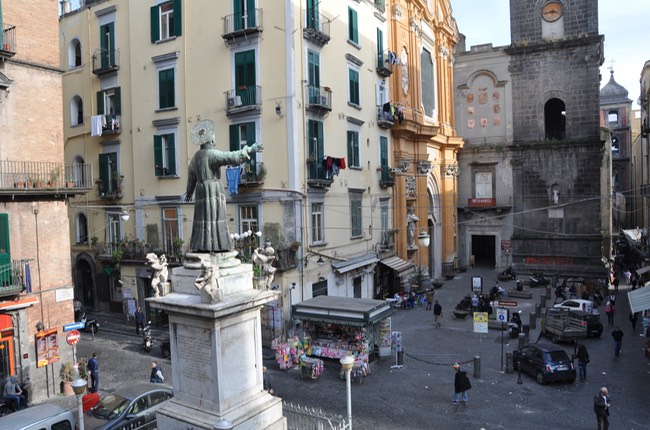
It is a short seventy minutes on a direct train from Rome to Naples, but that seventy minutes brings you to a different world altogether. It’s hard to define what it is about this city that I love so much. It is large and noisy, full of garbage and motorcycles, and definitely stressful to navigate. But the minute I stepped out of the train station, and felt the bright spring sunshine and the touch of humidity in the air, and saw the tall, pastel-coloured buildings, I felt myself smiling and thinking: I am back.
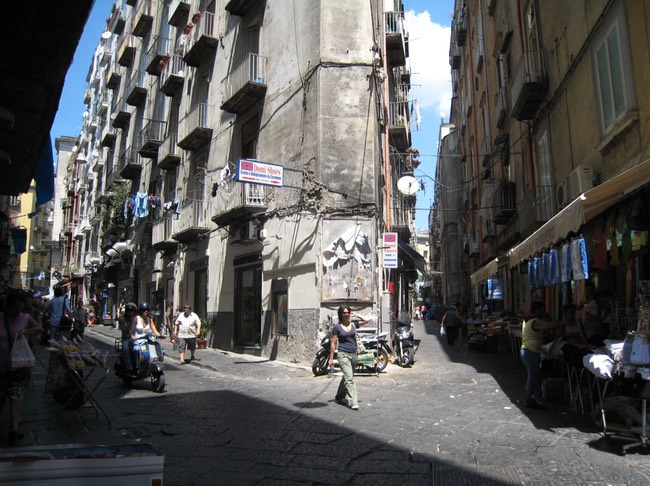
The buildings are tall, in the colours of the Mediterranean, but faded and peeling. Laundry hangs from the windows and balconies, and across the narrow streets of the old quarter. This area, known as Spaccanapoli, extends from the train station to the foot of the Vomero hill, and is as quintessential a southern Italian city as one can imagine. The areas closer to the station are quieter, largely untouristed, and decidedly smelly. But once past the Via Duomo, there is a subtle change, and the characteristic cobblestone streets are lined with shops and pizzerie.
These streets, shaded by tall buildings, are often more narrow than the lane behind my house at home; and yet, periodically, a car or even small truck will force its way through the crowds of pedestrians, patiently moving forward while we swirl around both sides of it like the water moving around a large rock. Motorcycles are everywhere, less patient than the cars, more willing to lean on the horn if they aren’t getting through quickly enough.
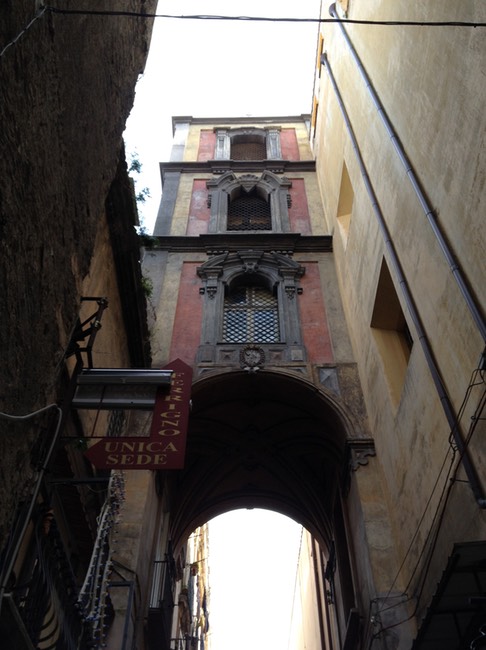
There are two main streets that wind their way through Spaccanapoli. One is Via dei Tribunali; the other is the combined route of Via San Biagio dei Librai and its continuation, Via Benedetto Croce. These two routes are joined by the short, picturesque Via San Gregorio Armeno. We walked down this crooked little street, which passes through a tall arch halfway down the hill; it was our first destination on our day trip from Rome, as we were in search of additions to our Italian nativity scene, first bought here almost five years ago.
The street is lined with these shops, some of which sell more mass-produced items, but some of which are highly artisanal. Look for the shops with workbenches at the back; those will be selling figurines made in-house, and they are particularly beautiful. I bought sheep and a shepherd, and a pair of angels, to supplement my original stable-scene; my son bought some market figures for his Christmas village.
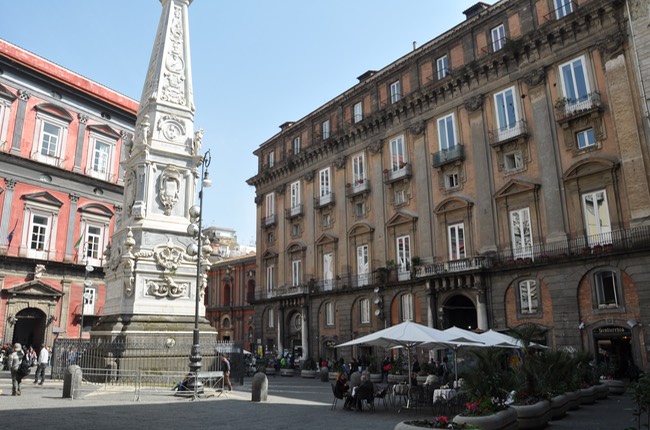
Further along, Via San Biago runs into the lovely Piazza San Domenico Maggiore. My memories of this piazza go back to our first visit to Napoli, when our son was not quite four, and it was a place where we could safely let him run, kicking his pink inflatable soccer ball around and around the piazza. The second time, we stayed in an apartment a few steps away, and we spent many an hour here at a shady café table, playing cards and enjoying a glass of limoncello. In this square is located the outstanding Pasticcieria Scaturchio, maker of heavenly pastry. This time, we sat in the square with our sfogliatelle, layer upon layer of thin pastry crust, with a rich, creamy centre.
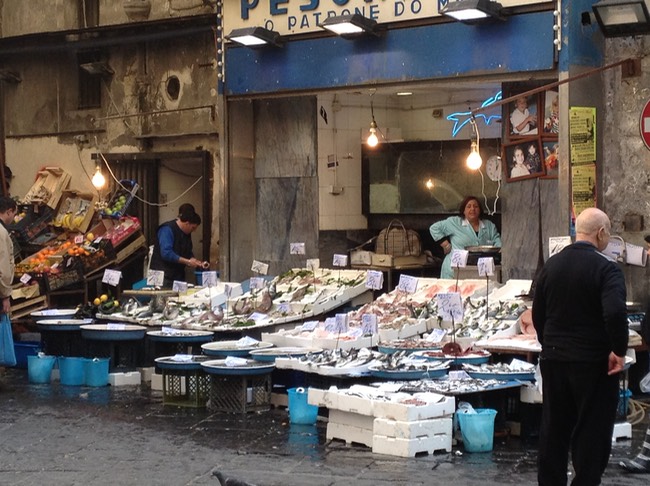
At the end of the centro storico, we passed through Via Pignasecca, where beautiful fresh produce, already in season even in March, was spread out for sale: tomatoes, artichokes, fava beans, flowering zucchine, and all kinds of greens. Just beyond the market is the funicular train that runs up the hill to the Vomero district, where we strolled peaceful streets and enjoyed spectacular views over Napoli, the harbour, and the not-too-distant Vesuvio. There is a small piazza where tour buses stop (we laughed at the sign forbidding the playing of soccer, and at all the soccer balls that lay further down the hill), but we took an expensive but charming table at a bar with a big patio, and drank limoncello and admired the view.

We went back down the hill by way of the scala, or stairway, that winds down the hillside past small quiet streets and houses. On our way back through Spaccanapoli, we discovered that the large Basilica di San Paolo Maggiore was open (for the first time in three visits!) so we took the opportunity to climb its stairs and admire the lovely Gothic interior. Then, thoroughly exhausted, we went to the incomparable Pizzeria di Matteo, where we were given a warm welcome and a corner table, and enjoyed some of the best pizza in the world.
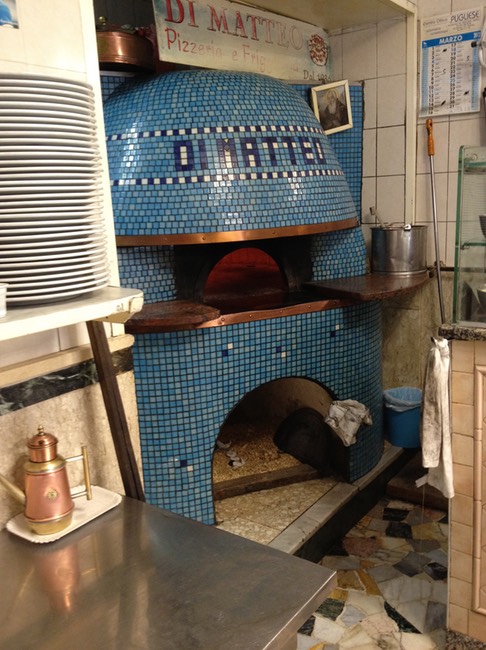
Not everyone may agree, but in our view, la vera pizza napoletana is simply the best pizza anywhere. The crusts are thin in the centre, light and puffy around the outside, blackened and crisp in places, and soft and chewy overall. The classic toppings are perfection; I would rather eat an excellent pizza margherita than all the gourmet toppings that the new world can provide. We have had pizza in North America that was certified as la vera pizza napoletana, but it has never been as delicious as the pizza we have enjoyed in Napoli. An excellent reason for a seventy-minute train ride from Rome!
There is no place quite like Napoli. The city struggles nowadays with the myriad challenges of poverty and crime, and the buildings look like they haven’t been painted in a hundred years. In my mind I see it as it would have been long ago, a beautiful old city on one of the most beautiful harbours in the world. Its current reality is more gritty, but its atmosphere is exhilarating– belligerent, energetic, defiant, joyful.
Photos: Spaccanapoli; streets of old Napoli; Via San Gregorio Armeno; Piazza San Domenico Maggiore; fish market on Via Pignasecca; a found soccer ball on the Vomero hillside; Basilica di San Paolo Maggiore; oven at Pizzeria di Matteo; view over Napoli

